Lavender Field Detection via Remote Sensing and Machine Learning for Optimal Hive Placement to Maximize Lavender Honey Production
Abstract
1. Introduction
1.1. Honey Statistics
1.2. Lavender and Beekeeping
1.3. Methods to Detect Lavenders
1.4. Objectives
2. Materials and Methods
2.1. Study Area
2.2. Aerial Data
2.3. Field Data
2.4. Auxiliary Data
2.4.1. Lavender’s Melliferous Potential
2.5. Object Detection via Deep Learning
2.6. Machine Learning Classification
2.6.1. Maximum Likelihood
2.6.2. Support Vector Machine
2.6.3. Random Tree Forest
2.7. Accuracy Assessments
2.8. Mapping Melliferous Potential of Lavenders
2.9. Optimal Hive Placement to Maximize Lavender Honey Production
3. Results and Discussions
3.1. Machine Learning Classification
3.2. Deep Learning Object Detection
3.3. Accuracy Assessments
3.4. Result Lavender Map
3.5. Mapping Melliferous Potential of Lavenders
3.6. Optimal Hive Placement to Maximize Lavender Honey Production
4. Conclusions
Author Contributions
Funding
Data Availability Statement
Conflicts of Interest
References
- Maris, N.; Mansor, S.; Shafri, H. Apicultural Site Zonation Using GIS and Multi-Criteria Decision Analysis. J. Trop. Agric. Sci. 2008, 31, 147–162. [Google Scholar]
- Oldroyd, P.B.; Nanork, P. Conservation of Asian honey-bees. Apidologie 2009, 40, 296–312. [Google Scholar] [CrossRef]
- Estoque, R.C.; Murayama, Y. Suitability Analysis for Beekeeping Sites in La Union, Philippines, Using GIS and Multi-Criteria Evaluation Techniques. Res. J. Appl. Sci. 2010, 5, 242–253. [Google Scholar] [CrossRef]
- Estoque, R.C.; Murayama, Y. Suitability Analysis for Beekeeping Sites Integrating GIS & MCE Techniques. In Spatial Analysis and Modeling in Geographical Transformation Process; Springer: Dordrecht, The Netherlands, 2011; ISBN 978-94-007-0670-5. [Google Scholar]
- Damián, G.C. GIS-Based Optimal Localisation of Beekeeping in Rural Kenya. Master’s Thesis, Lund University, Lund, Sweden, 2016. [Google Scholar]
- Ministry of Agriculture and Forestry. Turkish Beekeeping Statistics. Available online: https://arastirma.tarimorman.gov.tr/tepge/Belgeler/PDF%20%C3%9Cr%C3%BCn%20Raporlar%C4%B1/2022%20%C3%9Cr%C3%BCn%20Raporlar%C4%B1/Ar%C4%B1c%C4%B1l%C4%B1k%20%C3%9Cr%C3%BCn%20Raporu%202022-351%20TEPGE.pdf (accessed on 7 July 2025).
- Doğaroğlu, M. Modern Arıcılık Teknikleri Kitabı; Doğa Arıcılık Tic.: Tekirdağ, Turkey, 2004; pp. 64, 65, 87–97. [Google Scholar]
- Pehlivan, T. Türkiyede Üretilen Bazı Monofloral Balların Antioksidan ve Antibakteriyel Özelliklerinin Belirlenmesi. Ph.D. Thesis, Mustafa Kemal Üniversitesi, Fen Bilimleri Enstitüsü, Antakya, Turkey, 2015. [Google Scholar]
- Gül, A. Türkiye’de Üretilen Bazı Monofolaral Bal Örneklerinin Biyokimyasal Özelliklerinin Belirlenmesi. Türk Tarım Gıda Bilim Ve Teknol. Derg. 2016, 4, 1123–1126. [Google Scholar] [CrossRef][Green Version]
- Adam, K.L. Lavender Production, Products, Markets, and Entertainment Farms; Retrieved November; NCAT: Butte, MT, USA, 2006; Volume 5. [Google Scholar]
- Richardson, K. Beekeeping role in enhancing food security and environmental public health. Health Econ. Manag. Rev. 2023, 4, 69–79. [Google Scholar] [CrossRef]
- Yusuf, S.F.G.; Cishe, E.; Skenjana, N. Beekeeping and crop farming integration for sustaining beekeeping cooperative societies: A case study in Amathole District, South Africa. GeoJournal 2018, 83, 1035–1051. [Google Scholar] [CrossRef]
- Saunders, M.E.; Smith, T.J.; Rader, R. Bee conservation: Key role of managed bees. Science 2018, 360, 389. [Google Scholar] [CrossRef] [PubMed]
- Kozuharova, E.; Vereecken, N.J. Lavender production in SE Dobrudja–intensive agriculture impacts pollinators’ density and diversity. Euro-Mediterr. J. Environ. Integr. 2024, 9, 937–943. [Google Scholar] [CrossRef]
- Kolayli, S.; Can, Z.; Kara, Y.; Ozkok, A.; Ozmert Ergin, S.; Kemal, M.; Demir Kanbur, E. Physicochemical characteristics, phenolic components, and antioxidant capacities of lavender honey (Lavandula Spp.) from Isparta region of Türkiye. Chem. Biodivers. 2024, 21, e202400718. [Google Scholar] [CrossRef]
- Ergin, S.Ö. Antioxidant activity and physicochemical properties of lavender honey enriched with turmeric (Curcuma longa L.). J. Food Meas. Charact. 2025, 19, 1458–1468. [Google Scholar] [CrossRef]
- Rhodes, C.J. Pollinator decline–an ecological calamity in the making? Sci. Prog. 2018, 101, 121–160. [Google Scholar] [CrossRef] [PubMed]
- Le Conte, Y.; Navajas, M. Climate change: Impact on honey bee populations and diseases. Rev. Sci. Tech. Off. Int. Epizoot. 2008, 27, 499–510. [Google Scholar]
- Albacete, S.; Sancho, G.; Azpiazu, C.; Rodrigo, A.; Molowny-Horas, R.; Sgolastra, F.; Bosch, J. Bees exposed to climate change are more sensitive to pesticides. Glob. Change Biol. 2023, 29, 6248–6260. [Google Scholar] [CrossRef] [PubMed]
- Greenleaf, S.S.; Williams, N.M.; Winfree, R.; Kremen, C. Bee foraging ranges and their relationship to body size. Oecologia 2007, 153, 589–596. [Google Scholar] [CrossRef]
- Van der Steen, J.J.M. The foraging honey bee. BBKA News Br. Bee J. 2015, 2015, 43–46. [Google Scholar]
- Awad, A.M.; Owayss, A.A.; Iqbal, J.; Raweh, H.S.A.; Alqarni, A.S. GIS Approach for Determining the Optimum Spatiotemporal Plan for Beekeeping and Honey Production in Hot-Arid Subtropical Ecosystems. J. Econ. Entomol. 2019, 112, 1032–1042. [Google Scholar] [CrossRef] [PubMed]
- Vadnais, J.; Perez, L.; Coallier, N. Assessing foraging landscape quality in Quebec’s commercial beekeeping through remote sensing, machine learning, and survival analysis. J. Environ. Manag. 2005, 374, 124157. [Google Scholar] [CrossRef]
- Binboğa, Z.M.G.; Demirbaş, N. Türkiye’nin lavanta üretim ve diş ticaretinde ortaya çikan gelişmeler ve mevcut potansiyelin değerlendirilmesi için öneriler. In Proceedings of the Africa 3th International Conference on New Horizons in Sciences, Hurghada, Egypt, 22–25 September 2023. [Google Scholar]
- Bah, M.D.; Hafiane, A.; Canals, R. CRowNet: Deep network for crop row detection in UAV images. IEEE Access 2019, 8, 5189–5200. [Google Scholar] [CrossRef]
- Velusamy, P.; Rajendran, S.; Mahendran, R.K.; Naseer, S.; Shafiq, M.; Choi, J.G. Unmanned Aerial Vehicles (UAV) in precision agriculture: Applications and challenges. Energies 2021, 15, 217. [Google Scholar] [CrossRef]
- Bouguettaya, A.; Zarzour, H.; Kechida, A.; Taberkit, A.M. Deep learning techniques to classify agricultural crops through UAV imagery: A review. Neural Comput. Appl. 2022, 34, 9511–9536. [Google Scholar] [CrossRef]
- Shahi, T.B.; Xu, C.Y.; Neupane, A.; Guo, W. Recent advances in crop disease detection using UAV and deep learning techniques. Remote Sens. 2023, 15, 2450. [Google Scholar] [CrossRef]
- Richards, J.A. Supervised classification techniques. In Remote Sensing Digital Image Analysis; Springer: Cham, Switzerland, 2022; pp. 263–367. [Google Scholar]
- Kotsiantis, S.B.; Zaharakis, I.; Pintelas, P. Supervised machine learning: A review of classification techniques. Emerg. Artif. Intell. Appl. Comput. Eng. 2007, 160, 3–24. [Google Scholar]
- Statnikov, A.; Wang, L.; Aliferis, C.F. A comprehensive comparison of random forests and support vector machines for microarray-based cancer classification. BMC Bioinform. 2008, 9, 319. [Google Scholar] [CrossRef] [PubMed]
- Santafe, G.; Iñaki, I.; Jose, A.L. Dealing with the evaluation of supervised classification methods. Artif. Intell. Rev. 2015, 44, 467–508. [Google Scholar] [CrossRef]
- Prasanna, P.L.; Rao, D.R.; Meghana, Y.; Maithri, K.; Dhinesh, T. Analysis of supervised classification techniques. Int. J. Eng. Technol. 2017, 7, 283–285. [Google Scholar] [CrossRef]
- Ahmad, I.; Basheri, M.; Iqbal, M.J.; Rahim, A. Performance comparison of support vector machine, random forest, and extreme learning machine for intrusion detection. IEEE Access 2018, 6, 33789–33795. [Google Scholar] [CrossRef]
- Bangira, T.; Alfieri, S.M.; Menenti, M.; Van Niekerk, A. Comparing thresholding with machine learning classifiers for mapping complex water. Remote Sens. 2019, 11, 1351. [Google Scholar] [CrossRef]
- Shih, H.C.; Stow, D.A.; Tsai, Y.H. Guidance on and comparison of machine learning classifiers for Landsat-based land cover and land use mapping. Int. J. Remote Sens. 2019, 40, 1248–1274. [Google Scholar] [CrossRef]
- Sheykhmousa, M.; Mahdianpari, M.; Ghanbari, H.; Mohammadimanesh, H.; Ghamisi, P.; Homayouni, S. Support Vector Machine Versus Random Forest for Remote Sensing Image Classification: A Meta-Analysis and Systematic Review. IEEE J. Sel. Top. Appl. Earth Obs. Remote Sens. 2020, 13, 6308–6325. [Google Scholar] [CrossRef]
- Barghi, B.; Azadeh-Fard, N. Predicting risk of sepsis, comparison between machine learning methods: A case study of a Virginia hospital. Eur. J. Med. Res. 2002, 27, 213. [Google Scholar] [CrossRef] [PubMed] [PubMed Central]
- Gislason, P.O.; Benediktsson, J.A.; Sveinsson, J.R. Random forests for land cover classification. Pattern Recognit. Lett. 2006, 27, 294–300. [Google Scholar] [CrossRef]
- Cihlar, J.; Latifovic, R.; Beaubien, J. A comparison of clustering strategies for unsupervised classification. Can. J. Remote Sens. 2000, 26, 446–454. [Google Scholar]
- Chaovalit, P.; Zhou, L. Movie review mining: A comparison between supervised and unsupervised classification approaches. In Proceedings of the 38th Annual Hawaii International Conference on System Sciences, Big Island, HU, USA, 3–6 January 2005; p. 112c. [Google Scholar]
- Enderle, D.I.; Weih, R.C., Jr. Integrating supervised and unsupervised classification methods to develop a more accurate land cover classification. J. Ark. Acad. Sci. 2005, 59, 65–73. [Google Scholar]
- Richards, J.A. Clustering and unsupervised classification. In Remote Sensing Digital Image Analysis: An Introduction; Springer: Cham, Switzerland, 2013; pp. 319–341. [Google Scholar]
- Olaode, A.; Naghdy, G.; Todd, C. Unsupervised classification of images: A review. Int. J. Image Process. 2014, 8, 325–342. [Google Scholar]
- Zou, K.; Chen, Z.; Shi, Y.G.; Ye, J. Object Detection in 20 Years: A Survey. Proc. IEEE 2023, 111, 257–276. [Google Scholar] [CrossRef]
- Republic of Türkiye Ministry of Culture and Tourism Official Web Site. Available online: https://isparta.ktb.gov.tr/# (accessed on 16 November 2024).
- Isparta Valiliği Official Web Page. Available online: http://isparta.gov.tr/isparta-da-bal-ormanlarinin-sayisi-17ye-ulasti (accessed on 7 July 2025).
- Republic of Türkiye Ministry of Industry and Technology. Lavender Farming and Industry Feasibility Report 2020. Available online: https://baka.gov.tr/assets/upload/dosyalar/lavanta-tarimi-ve-endustrisi.pdf (accessed on 16 November 2024).
- Turkish Statistical Institute Official Web Site. Lavender Production Statistics. Available online: https://data.tuik.gov.tr/Bulten/Index?p=Bitkisel-Uretim-Istatistikleri-2022-45504 (accessed on 16 November 2024).
- Sarvia, F.; De Petris, S.; Borgogno-Mondino, E. Mapping melliferous potential in productive honey areas through spatial tools: Towards a rationalization of beekeeping. Ecol. Inform. 2023, 78, 102362. [Google Scholar] [CrossRef]
- Mačukanović-Jocić, M.; Jarić, S. The melliferous potential of apiflora of southwestern Vojvodina (Serbia). Arch. Biol. Sci. 2016, 68, 81–91. [Google Scholar] [CrossRef]
- Ricciardelli, D.; Albore, G.; Intoppa, F. Fiori e Api. In La flora Visitata dalle Api e Dagli Altri Apoidei in Europa; Edagricole-Edizioni Agricole della Calderini srl.: Bologna, Italy, 2000. [Google Scholar]
- Crane, E.; Walker, P.; Day, R. Directory of Important World Honey Sources; Ulutaş, K., Özkirim, A., Eds.; International Bee Research Association, Minnesota University: Minneapolis, MN, USA, 2018; pp. 30–35. [Google Scholar]
- Xiao, Y.; Tian, Z.; Yu, J.; Zhang, Y.; Liu, S.; Du, S.; Lan, X. A review of object detection based on deep learning. Multimed. Tools Appl. 2020, 79, 23729–23791. [Google Scholar] [CrossRef]
- Pathak, A.R.; Pandey, M.; Rautaray, S. Application of Deep Learning for Object Detection. Procedia Comput. Sci. 2018, 132, 1706–1717. [Google Scholar] [CrossRef]
- Songhui, M.; Mingming, S.; Chufeng, H. Objects detection and location based on mask RCNN and stereo vision. In Proceedings of the 2019 14th IEEE International Conference on Electronic Measurement & Instruments (ICEMI), Changsha, China, 1–3 November 2019. [Google Scholar]
- Delight, T.; Karunakaran, V. Deep Learning based Object Detection using Mask RCNN. In Proceedings of the 2021 6th International Conference on Communication and Electronics Systems (ICCES), Coimbatre, India, 8–10 July 2021; pp. 1684–1690. [Google Scholar] [CrossRef]
- Huang, C.; Davis, L.S.; Townshed, J.R.G. An assessment of support Vector Machines for Land cover classification. Int. J. Remote Sens. 2002, 23, 725–749. [Google Scholar]
- Mondal, A.; Kundu, S.; Chandniha, S.K.; Shukla, R.; Mishra, P.K. Comparison of support vector machine and maximum likelihood classification technique using satellite imagery. Int. J. Remote Sens. GIS 2012, 1, 116–123. [Google Scholar]
- Mustapha, M.R.; Lim, H.S.; Jafri, M.M. Comparison of neural network and maximum likelihood approaches in image classification. J. Appl. Sci. 2010, 10, 2847–2854. [Google Scholar] [CrossRef]
- Otukei, J.R.; Blaschke, T. Land cover change assessment using decision trees, support vector machines and maximum likelihood classification methods. Int. J. Appl. Earth Obs. Geoinf. 2010, 12, S27–S31. [Google Scholar] [CrossRef]
- Vapnik, W.N. An overview of statistical learning theory. IEEE Trans. Neural Netw. 1999, 10, 988–999. [Google Scholar] [CrossRef] [PubMed]
- Yang, N.; Li, S.; Liu, J.; Bia, F. Sensitivity of Support Vector Machine Classification to Various Training Features. TELKOMNIKA Indones. J. Electr. Eng. 2014, 12, 286–291. [Google Scholar] [CrossRef]
- Cervantes, J.; Garcia-Lamont, F.; Rodríguez-Mazahua, L.; Lopez, A. A comprehensive survey on support vector machine classification: Applications, challenges and trends. Neurocomputing 2020, 408, 189–215. [Google Scholar] [CrossRef]
- Vapnik, W.N.; Chervonenkis, A.Y. On the uniform convergence of the relative frequencies of events to their probabilities. Theory Probab. Its Appl. 1971, 17, 264–280. [Google Scholar] [CrossRef]
- Breiman, L. Random forests. Mach. Learn. 2001, 45, 5–32. [Google Scholar] [CrossRef]
- Khan, Z.; Gul, A.; Perperoglou, A.; Miftahuddin, M.; Mahmoud, O.; Adler, W.; Lausen, B. Ensemble of optimal trees, random forest and random projection ensemble classification. Adv. Data Anal. Classif. 2020, 14, 97–116. [Google Scholar] [CrossRef]
- Xu, Y.; Zhao, X.; Chen, Y.; Yang, Z. Research on a Mixed Gas Classification Method Based on Extreme Random Tree. Appl. Sci. 2019, 9, 1728. [Google Scholar] [CrossRef]
- Ali, J.; Khan, R.; Ahmad, N.; Maqsood, I. Random forests and decision trees. Int. J. Comput. Sci. Issues IJCSI 2012, 9, 272. [Google Scholar]
- Congalton, R.G. A review of assessing the accuracy of classifications of remotely sensed data. Remote Sens. Environ. 1991, 37, 35–46. [Google Scholar] [CrossRef]
- Ramsey, E.W.; Jensen, J.R. Remote sensing of mangrove wetlands: Relating canopy spectra to site-specific data. Photogramm. Eng. Remote Sens. 1996, 62, 939. [Google Scholar]
- Liu, C.; Fraizer, P.; Kumar, L. Comparative assessment of the measures of thematic classification accuracy. Remote Sens. Environ. 2007, 107, 606–616. [Google Scholar] [CrossRef]
- Fung, T.; LeDrew, E. The Determination of Optimal Threshold Levels for Change Detection Using Various Accuracy Indices. Photogramm. Eng. Remote Sens. 1988, 54, 1449–1454. [Google Scholar]
- Abd, H.A.A.R.; Alnajjar, H.A. Maximum Likelihood for Land-Use/Land-Cover Mapping and Change Detection Using Landsat Satellite Images: A Case Study South of Johor. Int. J. Comput. Eng. Res. 2013, 3, 26–33. [Google Scholar]
- Thoma, M. Analysis and optimization of convolutional neural network architectures. arXiv 2017, arXiv:1707.09725. [Google Scholar] [CrossRef]
- Al-Najjar, H.A.H.; Kalantar, B.; Pradhan, B.; Saeidi, V.; Halin, A.A.; Ueda, N.; Mansor, S. Land Cover Classification from fused DSM and UAV Images Using Convolutional Neural Networks. Remote Sens. 2012, 11, 1461. [Google Scholar] [CrossRef]
- Osborne, J.L.; Clark, S.J.; Morris, R.J.; Williams, I.H.; Riley, J.R.; Smith, A.D.; Edwards, A. A landscape-scale study of bumble bee foraging range and constancy, using harmonic radar. J. Appl. Ecol. 1999, 36, 519–533. [Google Scholar] [CrossRef]
- Gathmann, A.; Tscharntke, T. Foraging ranges of solitary bees. J. Anim. Ecol. 2002, 71, 757–764. [Google Scholar] [CrossRef]
- Takkis, K.; Tscheulin, T.; Tsalkatis, P.; Petanidou, T. Climate change reduces nectar secretion in two common Mediterranean plants. AoB Plants 2015, 7, plv111. [Google Scholar] [CrossRef] [PubMed]
- Descamps, C.; Quinet, M.; Jacquemart, A.L. Climate change–induced stress reduce quantity and alter composition of nectar and pollen from a bee-pollinated species (Borago officinalis, Boraginaceae). Front. Plant Sci. 2021, 12, 755843. [Google Scholar] [CrossRef] [PubMed]
- Zoccali, P.; Malacrinò, A.; Campolo, O.; Laudani, F.; Algeri, G.M.; Giunti, G.; Strano, C.P.; Benelli, G.; Palmeri, V. A novel GIS-based approach to assess beekeeping suitability of Mediterranean lands. Saudi J. Biol. Sci. 2017, 24, 1045–1050. [Google Scholar] [CrossRef] [PubMed]
- Abou-Shaara, H.F. Using geographical information system (GIS) and satellite remote sensing for understanding the impacts of land cover on apiculture over time. Int. J. Remote Sens. Appl. 2013, 3, 171–174. [Google Scholar] [CrossRef]
- Becher, M.A.; Grimm, V.; Thorbek, P.; Horn, J.; Kennedy, P.J.; Osborne, J.L. BEEHAVE: A systems model of honeybee colony dynamics and foraging to explore multifactorial causes of colony failure. J. Appl. Ecol. 2014, 51, 470–482. [Google Scholar] [CrossRef]
- Giannini, T.C.; Chapman, D.S.; Saraiva, A.M.; Alves-dos-Santos, I.; Biesmeijer, J.C. Improving species distribution models using biotic interactions: A case study of parasites, pollinators and plants. Ecography 2013, 36, 649–656. [Google Scholar] [CrossRef]
- Marnasidis, S.; Kantartzis, A.; Malesios, C.; Hatjina, F.; Arabatzis, G.; Verikouki, E. Mapping priority areas for apiculture development with the use of geographical information systems. Agriculture 2021, 11, 182. [Google Scholar] [CrossRef]
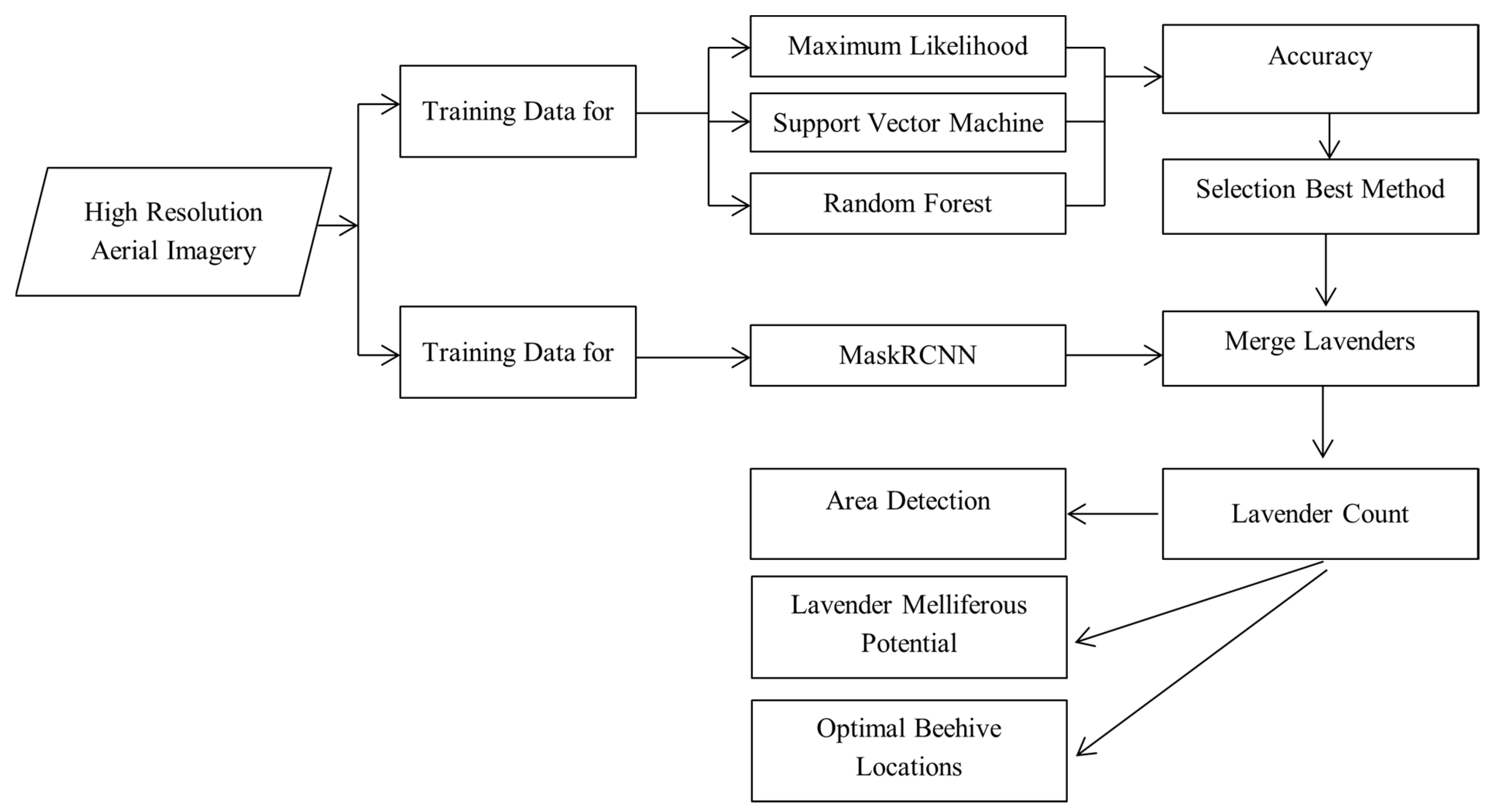
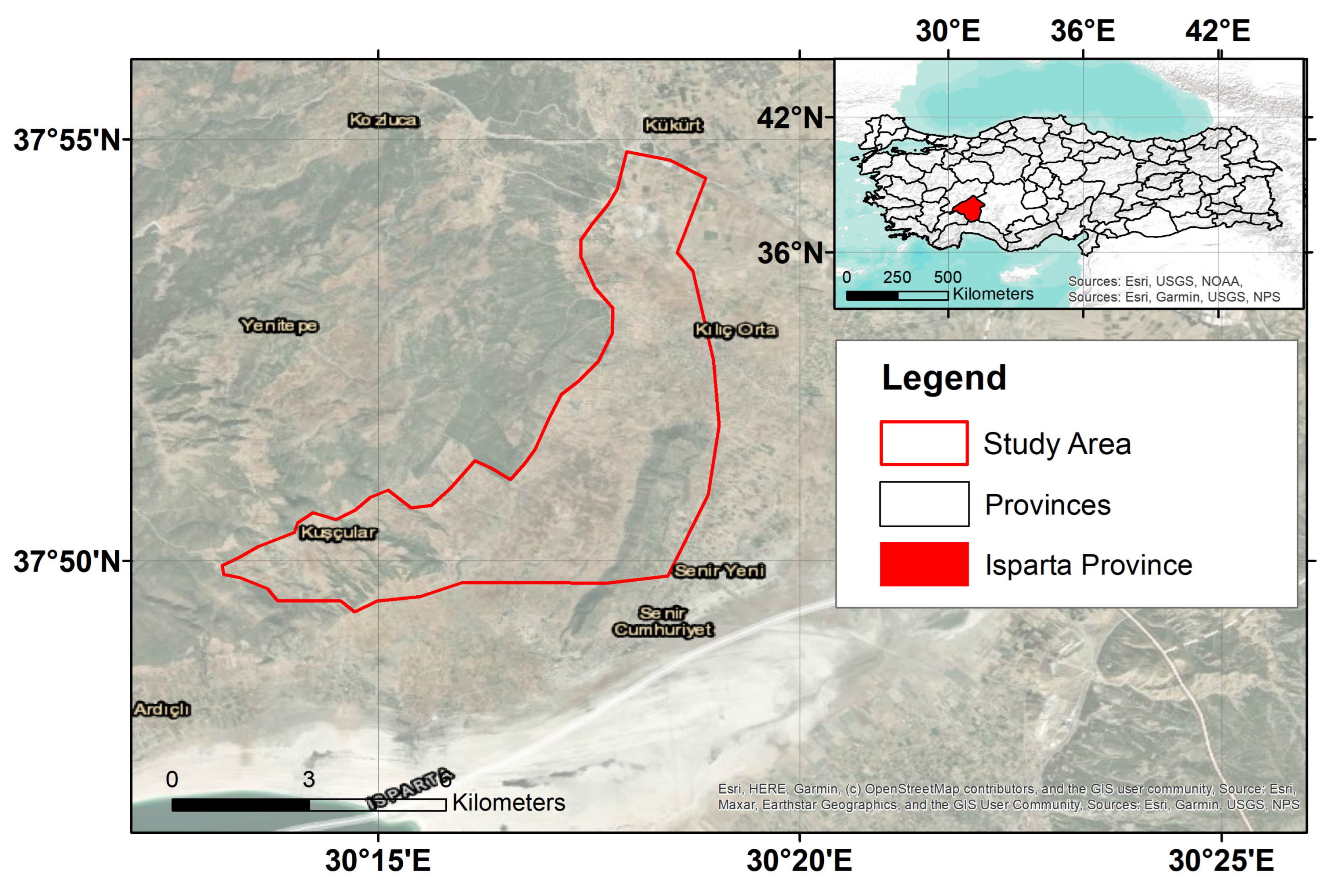
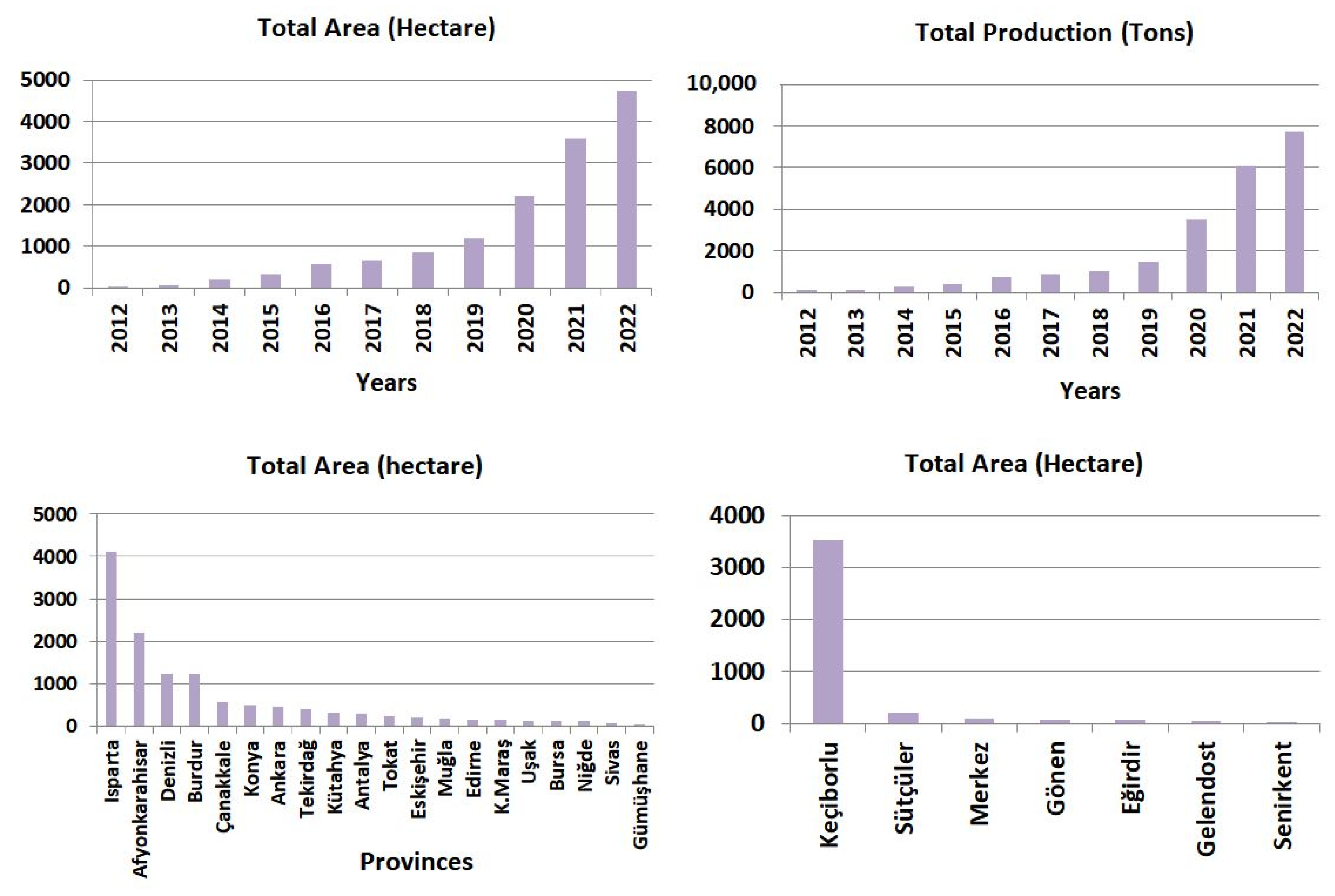

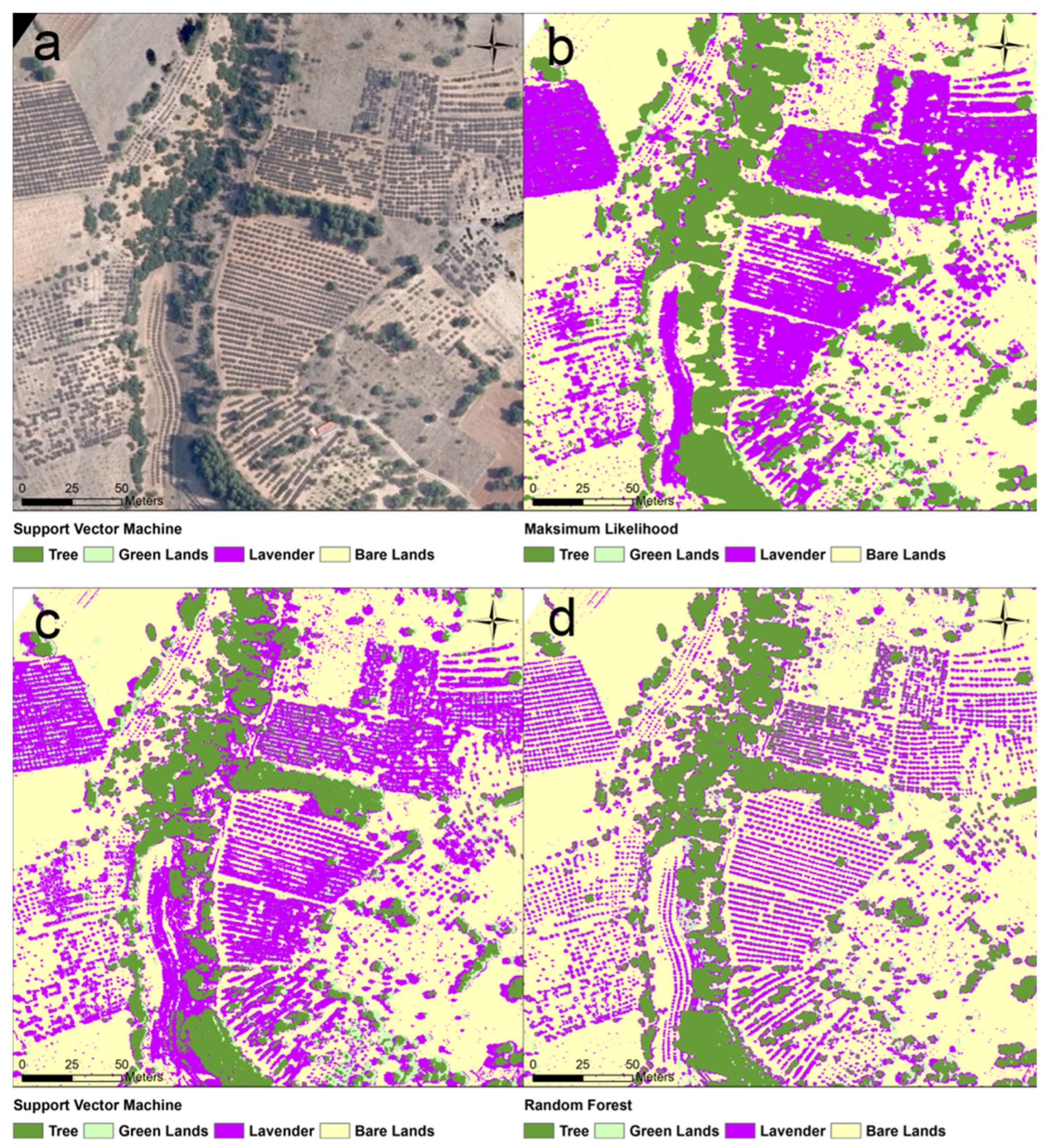
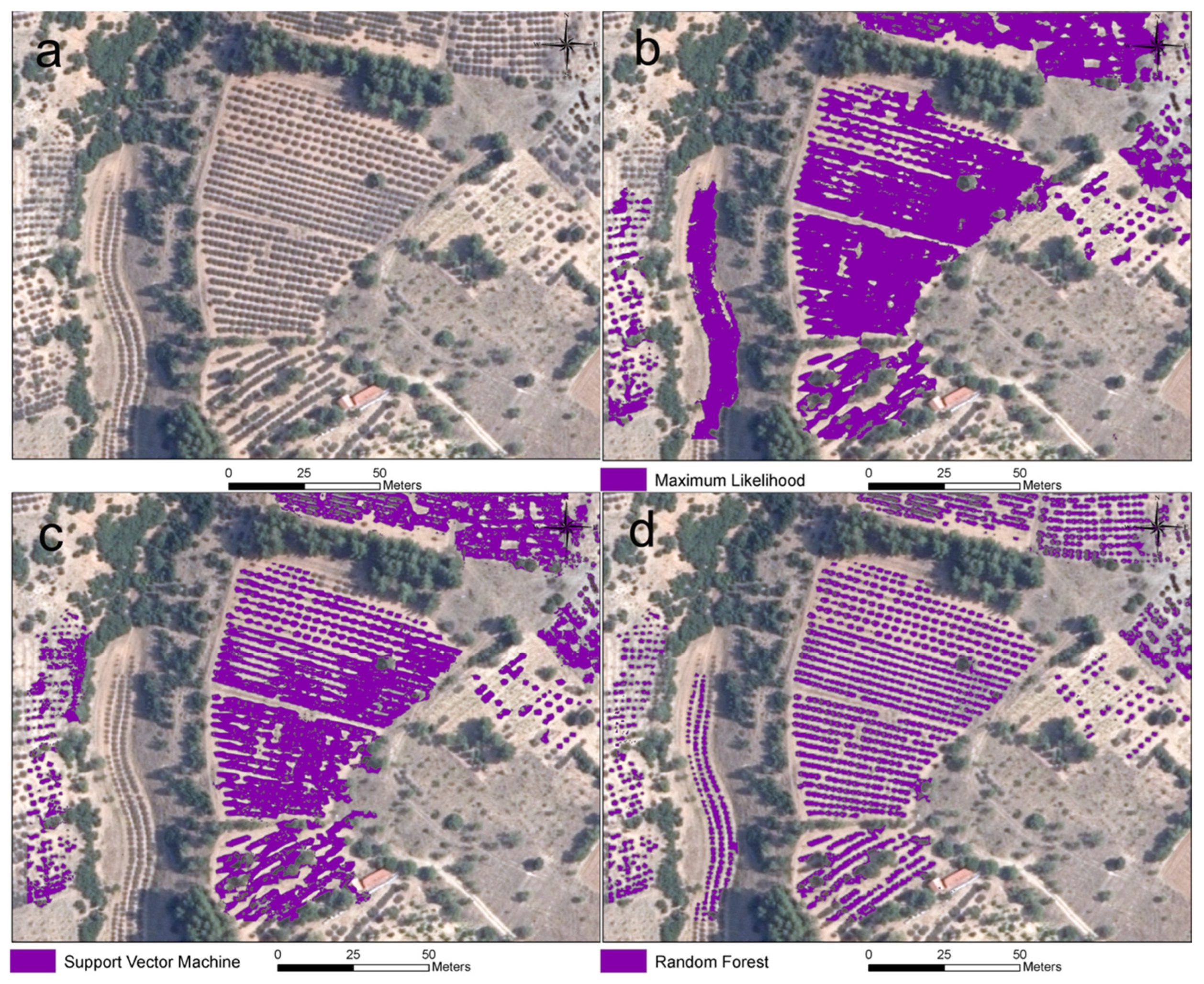
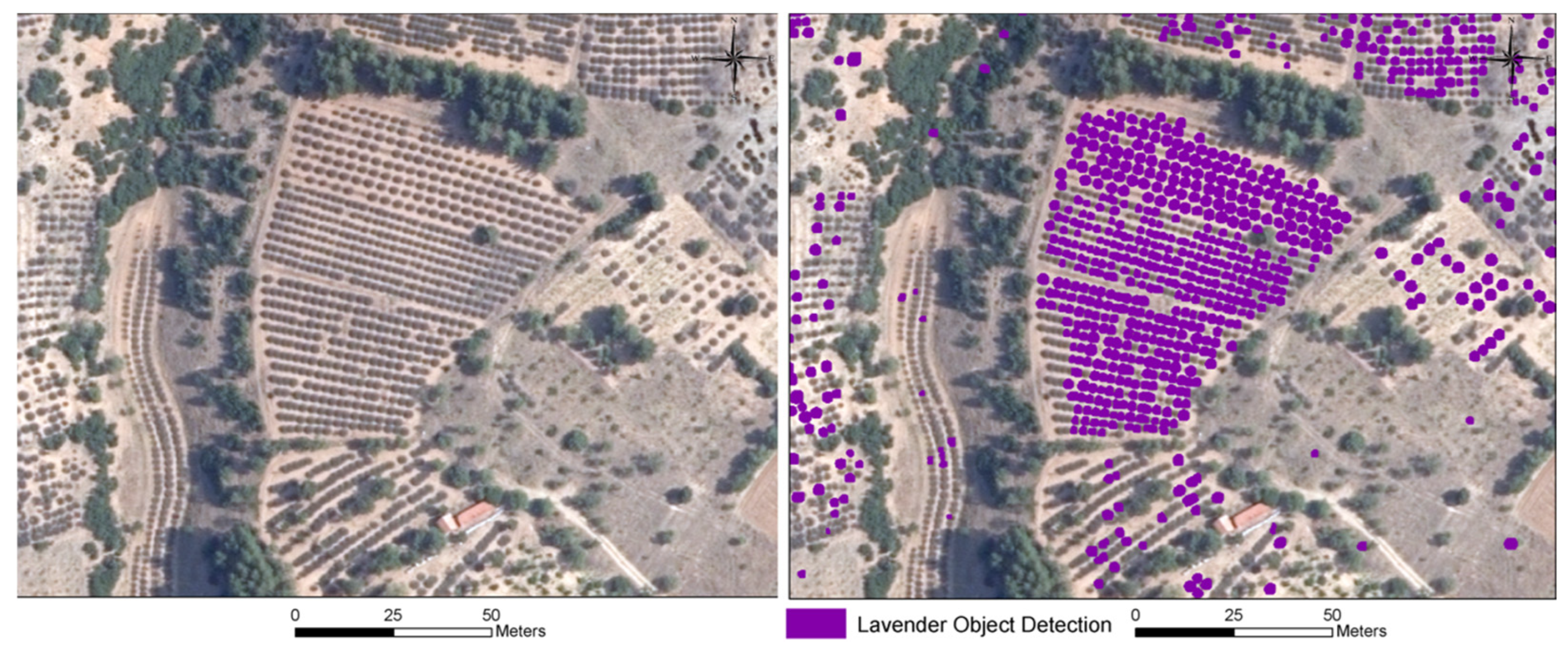
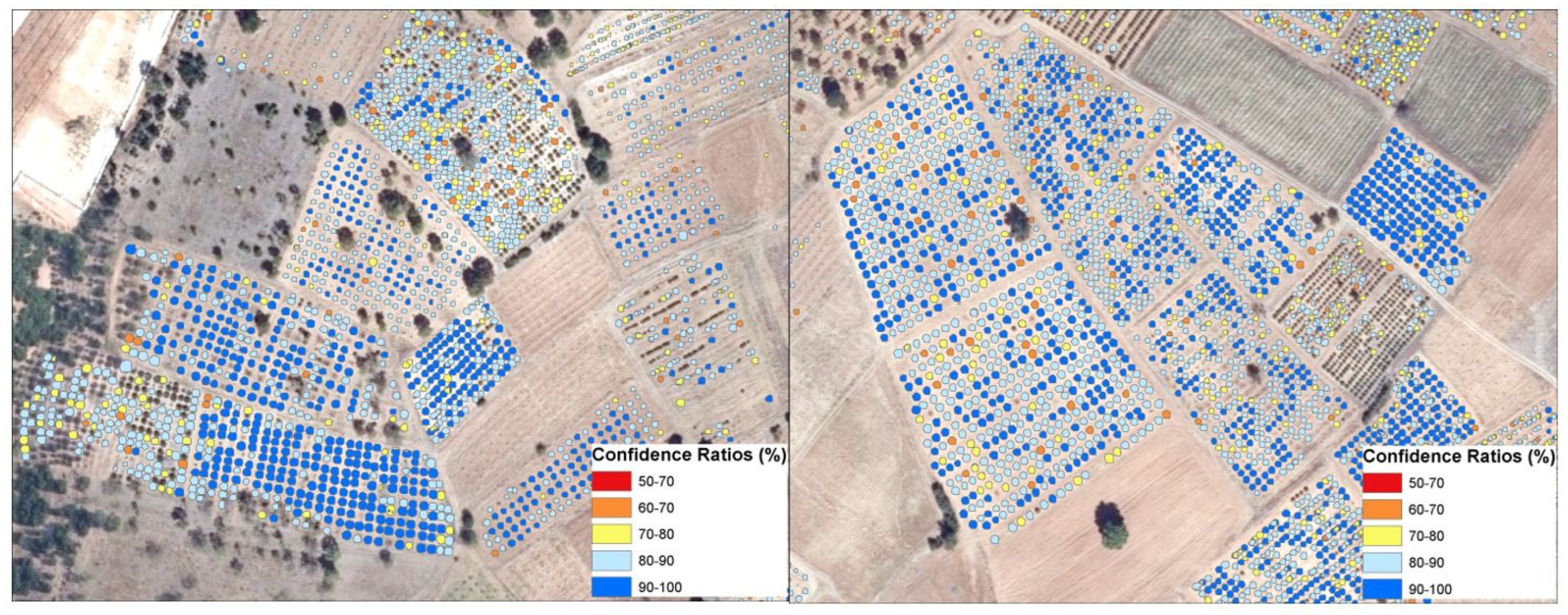

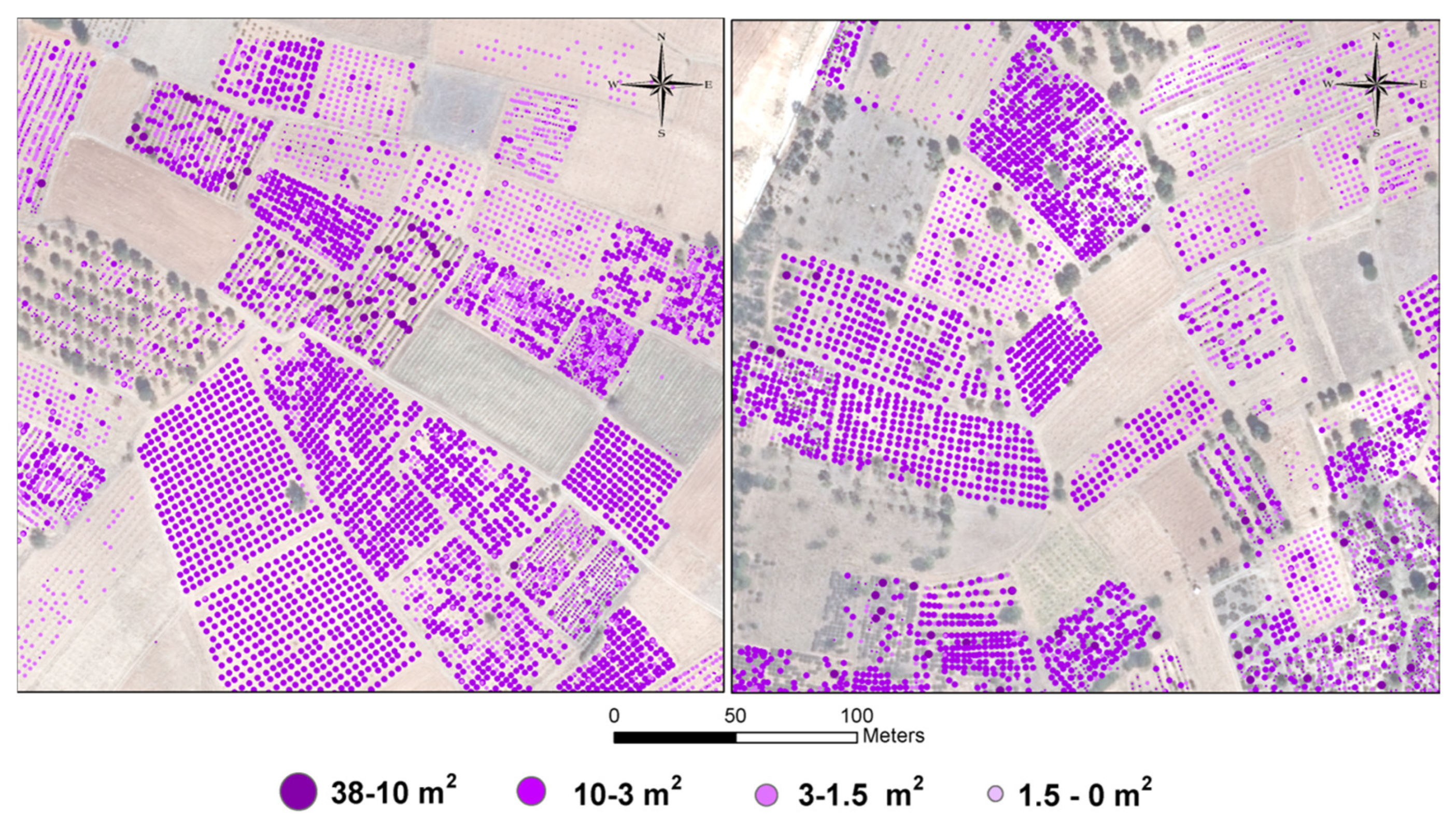
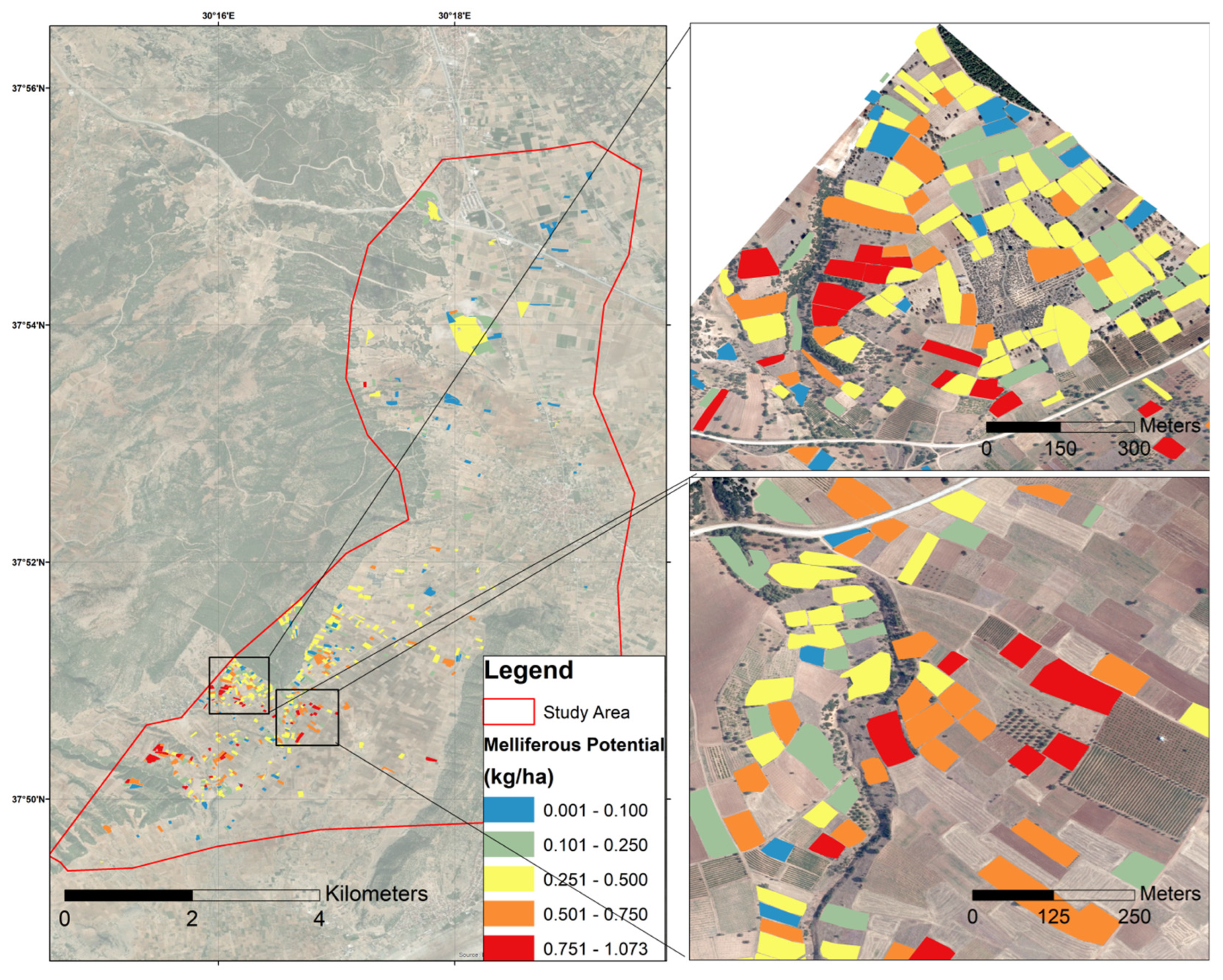

| Largest Lav. | Large Lav. | Medium Lav. | Small Lav. | Total | |
| Deep Learning | 715 | 736 | 546 | 615 | 2612 |
| Trees | Green Fields | Bare Lands | Lavenders | Total | |
| Classifications | 586 | 346 | 301 | 848 | 2081 |
| ML | RF | SVM | ||||
|---|---|---|---|---|---|---|
| Class | Km2 | % | Km2 | % | Km2 | % |
| Tree | 8.39 | 27.8 | 3.41 | 11.3 | 3.39 | 11.2 |
| Green Fields | 0.53 | 1.8 | 1.40 | 4.7 | 1.16 | 3.8 |
| Lavender | 1.53 | 5.1 | 6.46 | 21.4 | 3.13 | 10.4 |
| Bare Lands | 19.73 | 65.4 | 18.91 | 62.6 | 22.50 | 74.6 |
| Train Deep Learning | Object Detection | ||
|---|---|---|---|
| Metadata format | RCNN Mask | Padding | 8 |
| Batch Size | 4 | Threshold | 0.5 |
| Backbone Model | Resnet-50 | Max Overlap Ratio | 0.1 |
| Chip Size | 75 | Batch Size | 8 |
| Epochs | 250 | ||
| Lavender Type | Learning Rate | Sample Image | |
| Lavender Type 1 (Typically, flowers are in full bloom and have a diameter of more than 1.5 m.) | 0.75 | 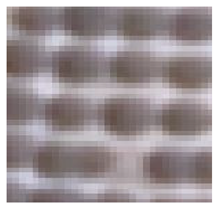 | |
| Lavender Type 2 (The flowers are in bloom and have a diameter of more than 1 m) | 0.76 | 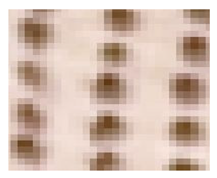 | |
| Lavender Type 3 (Lavenders with a diameter of up to 0.75 m) | 0.83 |  | |
| Lavender Type 4 (Lavenders with a diameter of up to 0.50 m) | 0.83 | 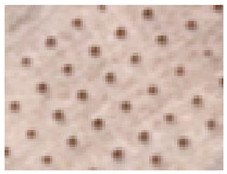 | |
| Maximum Likelihood | Support Vector Machine | Random Forest | ||||||||||
|---|---|---|---|---|---|---|---|---|---|---|---|---|
| Tree | Grass | Lavender | Agri. | Tree | Grass | Lavender | Agri. | Tree | Grass | Lavender | Agri. | |
| Error of Omission | 26.82 | 24.23 | 5.02 | 2.97 | 11.37 | 6.14 | 5.00 | 9.95 | 7.41 | 4.13 | 3.89 | 2.79 |
| Producer Accuracy | 0.73 | 0.76 | 0.95 | 0.97 | 0.89 | 0.94 | 0.95 | 0.90 | 0.93 | 0.96 | 0.96 | 0.97 |
| User Accuracy | 0.89 | 0.85 | 0.90 | 0.93 | 0.92 | 0.70 | 0.93 | 0.98 | 0.95 | 0.83 | 0.98 | 0.96 |
| Overall Accuracy | 0.91 | 0.93 | 0.96 | |||||||||
| Observed Agreement (P0) | 0.91 | 0.93 | 0.96 | |||||||||
| Chance Agreement (Pe) | 0.32 | 0.34 | 0.35 | |||||||||
| Kappa | 0.86 | 0.89 | 0.94 | |||||||||
Disclaimer/Publisher’s Note: The statements, opinions and data contained in all publications are solely those of the individual author(s) and contributor(s) and not of MDPI and/or the editor(s). MDPI and/or the editor(s) disclaim responsibility for any injury to people or property resulting from any ideas, methods, instructions or products referred to in the content. |
© 2025 by the authors. Licensee MDPI, Basel, Switzerland. This article is an open access article distributed under the terms and conditions of the Creative Commons Attribution (CC BY) license (https://creativecommons.org/licenses/by/4.0/).
Share and Cite
Sari, F.; Sarvia, F. Lavender Field Detection via Remote Sensing and Machine Learning for Optimal Hive Placement to Maximize Lavender Honey Production. Earth 2025, 6, 107. https://doi.org/10.3390/earth6030107
Sari F, Sarvia F. Lavender Field Detection via Remote Sensing and Machine Learning for Optimal Hive Placement to Maximize Lavender Honey Production. Earth. 2025; 6(3):107. https://doi.org/10.3390/earth6030107
Chicago/Turabian StyleSari, Fatih, and Filippo Sarvia. 2025. "Lavender Field Detection via Remote Sensing and Machine Learning for Optimal Hive Placement to Maximize Lavender Honey Production" Earth 6, no. 3: 107. https://doi.org/10.3390/earth6030107
APA StyleSari, F., & Sarvia, F. (2025). Lavender Field Detection via Remote Sensing and Machine Learning for Optimal Hive Placement to Maximize Lavender Honey Production. Earth, 6(3), 107. https://doi.org/10.3390/earth6030107







